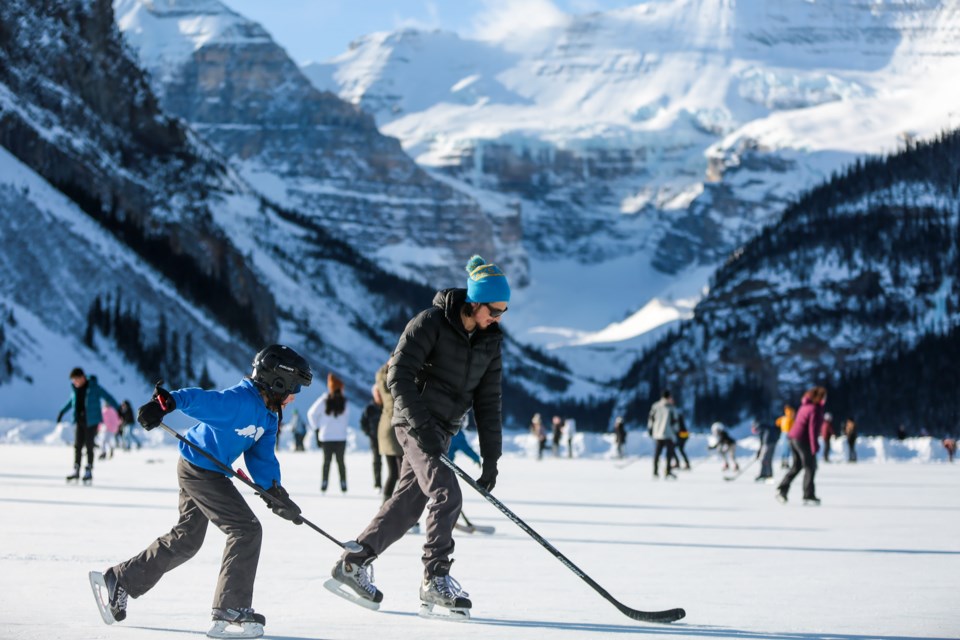BANFF – Public safety specialists in Banff National Park warn that residents and tourists may be skating on thin ice.
With glass-like skating conditions forming before the recent snowfall, skaters were taking to the various lakes and water bodies throughout the park, including some where ice conditions were sketchy.
“The ice has just formed and right now it can be pretty high risk if you chose to go way out on these water bodies,” said Steve Holeczi, a visitor safety specialist for Banff National Park.
“People should realize the consequences if you go in are pretty severe. I think a lot of people inherently know if I go in the water it sucks, but when it happens, it’s a big deal.”
The Canadian Red Cross, which has detailed information on ice safety, recommends the minimum ice thickness should be 15 cm for walking or skating alone or at least 20 cm for groups of skaters or games on the ice.
The colour of ice may be an indication of its strength, with clear blue ice being the strongest. White opaque or snow ice is half as strong as blue ice, while grey ice is unsafe, indicating the presence of water.
With local conditions and the type of water body affecting the ice strength, Holeczi said it’s a good idea for skaters to use an ice screw to take samples to determine how thick the ice is, wear a personal flotation devices (PFD) and carry an ice pick.
“The big message is that ice can vary wildly in thickness even when it looks just flat,” he said.
“The further out you get, the more committed you are if you go in. If I am right near shore, I’d rather be standing up if I fall in, that’s a consideration for people if you’re unsure.”
In January this year, at least four people fell though the ice at Lake Minnewanka over a two-day period, including a woman in her 20s who was taken to Mineral Springs Hospital with hypothermia after being rescued from the popular recreation spot.
Holeczi said the skating party was 500 or 600 metres out on the lake when the incident happened.
He said there were about 100 people on the lake at the time, but added that rescuing someone who falls through the ice can also be dangerous.
“By the time we got there it was probably over an hour later. They had managed to get themselves out onto the ice, but they wouldn’t have got back without help,” he said.
“Without intervention the outcome would have been much poorer. It illustrates how serious it is when it happens.”
If someone falls through the ice, remember the rule of 1-10-1 – one minute to get breathing under control; 10 minutes before losing effective use of hands, arms and legs, and at least 30 minutes for hypothermia to set in and about hour before loss of consciousness.
“You will deteriorate very quickly, so that’s something people need to think about,” said Holeczi.
If you fall through the ice and you’re alone, the Canadian Red Cross recommends:
- Resist the immediate urge to climb back out where you fell in because the ice is weak in this area.
- Try to relax and catch your breath.
- Reach forward onto the broken ice without pushing down, kick your legs to try to get your body into a horizontal position, and crawl onto the ice.
- When you are back on the ice, crawl on your stomach or roll away from the open area with your arms and legs spread out as far as possible to evenly distribute your body weight – and do not stand up.
When you are with others on the ice, the Red Cross recommends:
- Call for help. Consider whether you can quickly get help from trained professionals.
- Check if you can reach the person using a long pole or branch from shore – if so, lie down and extend the pole to the person.
- If you go onto ice, wear a PFD and carry a long pole or branch to test the ice in front of you.
- Bring something to reach or throw to the person (e.g. pole, weighted rope, line or tree branch).
- When near the break, lie down to distribute your weight and slowly crawl toward the hole. Remaining low, extend or throw your emergency rescue device (pole, rope, line or branch) to the person.
- Have the person kick while you pull them out.
Holeczi said Parks Canada does not monitor ice thickness in the park, adding there are far too many water bodies to do that.
“I think in the end, users have to chose how much risk they want to accept,” he said.




